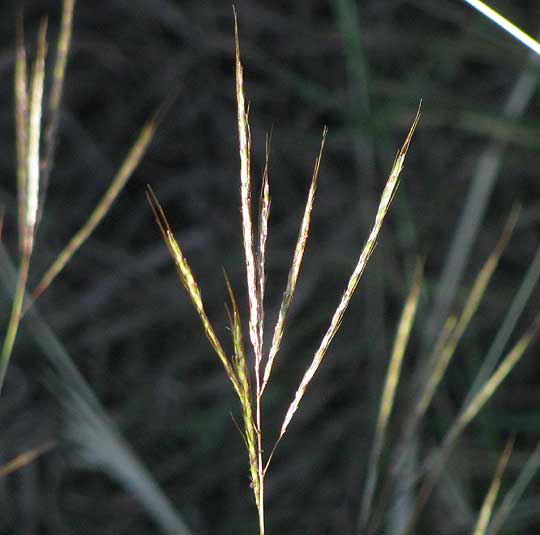Excerpts from Jim Conrad's
Naturalist Newsletter

from the November 4, 2012 Newsletter issued from the valley of the Dry Frio River in northern Uvalde County, southwestern Texas, on the southern border of the Edwards Plateau; elevation ~1750m (~5750 ft); N29.62°, W99.86°; USA
BIG BLUESTEM GRASS
For the last couple of weeks the grassy area around the cabin has developed a certain gauzy aura above it, a diffuse sort of cloud about knee high, with a hay-color and purple tinge to it. The gauziness is produced by untold millions of grass flower heads, or inflorescences, rising on slender peduncles above short grass blades. Right around the cabin the inflorescences hardly reach a foot tall, but in less trampled areas they can reach knee high and higher. Above you can see what I'm talking about, with individual inflorescences nearest us illuminated by late afternoon sunlight, and untold numbers of other inflorescences in pastures across the road turning the pastures pale.
You can see in that photo that individual inflorescences look a little like skyward-pointing turkey feet with very slender toes. In fact, Turkey Foot is one of the common names for this incredibly abundant and widely distributed grass. You can see a single inflorescence closer up below:

A close-up of a spikelet stuck on my fingertip with spit is shown below:

One thing that image shows is a feature peculiar to this kind of grass, which is that the spikelets are paired. Note that the larger, lower spikelet bears a long, stiff bristle or "awn" and has no stem, or pedicle, beneath it, while the smaller, upper one without an awn perches on a small stem, or pedicel. The larger, awned spikelet is fertile, producing a fruit, while the upper, smaller spikelet is sterile, bearing only male anthers, or nothing.
So, what is this super-abundant grass around the cabin?
In terms of North American history, we have before us one of the most important of all grasses. For, the vast grasslands in mid continent that became America's breadbasket and ranchland were populated by four main grass species -- the "Big Four," as they're often called. And this grass so abundant around the cabin and in pastures and open grassy areas in the woods for miles around not only is one of those four, but also it's the star of the four, the most important. The other three grass species are: Indiangrass, Sorghastrum nutans; Switchgrass, Panicum virgatum, and; Little Bluestem, Schizachyrium scoparium. The fourth, our "Turkey Foot" star of the Big Four -- is better known as Big Bluestem, ANDROPOGON GERARDII.
Big Bluestem doesn't get very big around here, but farther north where the tallgrass prairie once was better developed, the soil richer and deeper, and maybe with a climate more to its liking, it can reach ten feet high and higher (3m). It's hard to imagine that our little grass usually not even reaching the knees is the same species -- until you look at the flowers, and the flowers are unmistakably Little Bluestem flowers.
Big Bluestem is a perennial bunch grass. It's a tough and aggressive species that once established can crowd out other species. Big plants can saturate the soil with roots two feet deep (60cm), and penetrate twelve feet down (3.5m). After fires it resprouts, so it has an adaptive advantage over other species that can't recover as well from fires.
Big Bluestem is distributed across North America, except for the far western states and provinces, and extends into arid northern Mexico. As a forage plant, it has a good percentage of protein and is regarded as a good grass for pasturage. Maybe that's one reason Minnie the Cow spends so much time grazing next to our cabin.